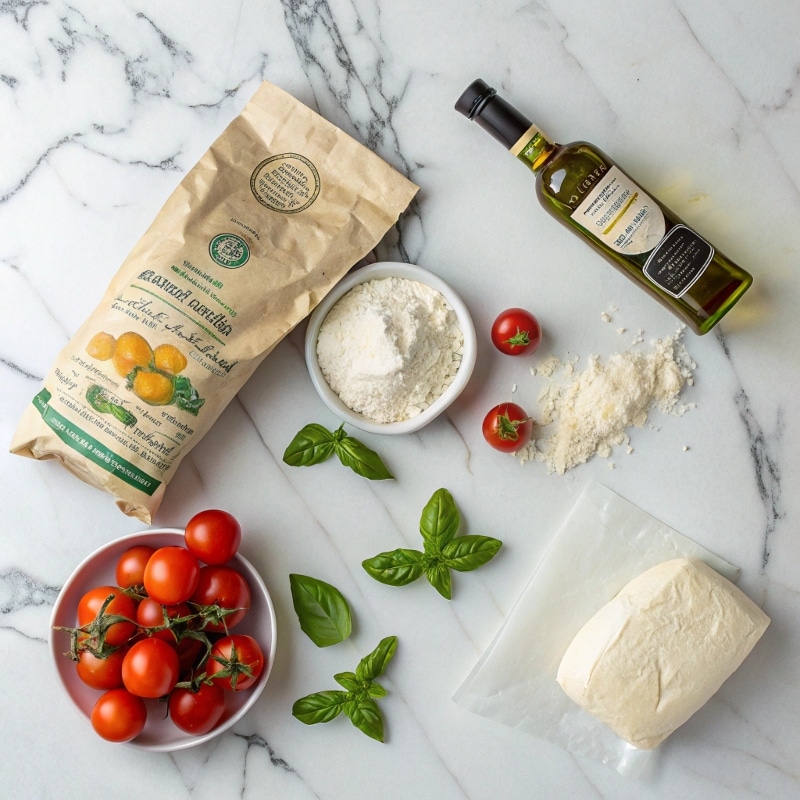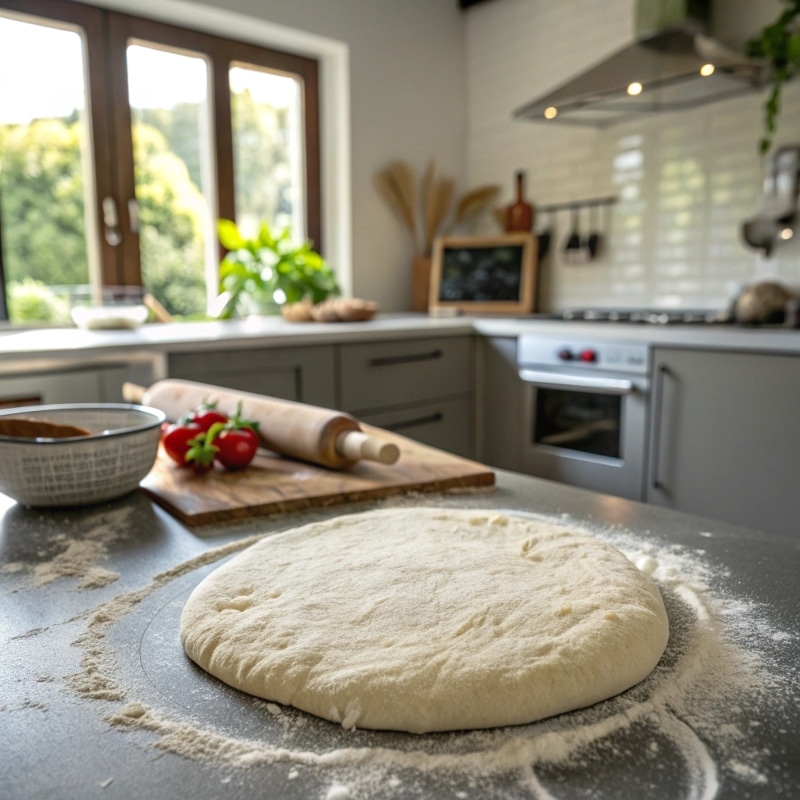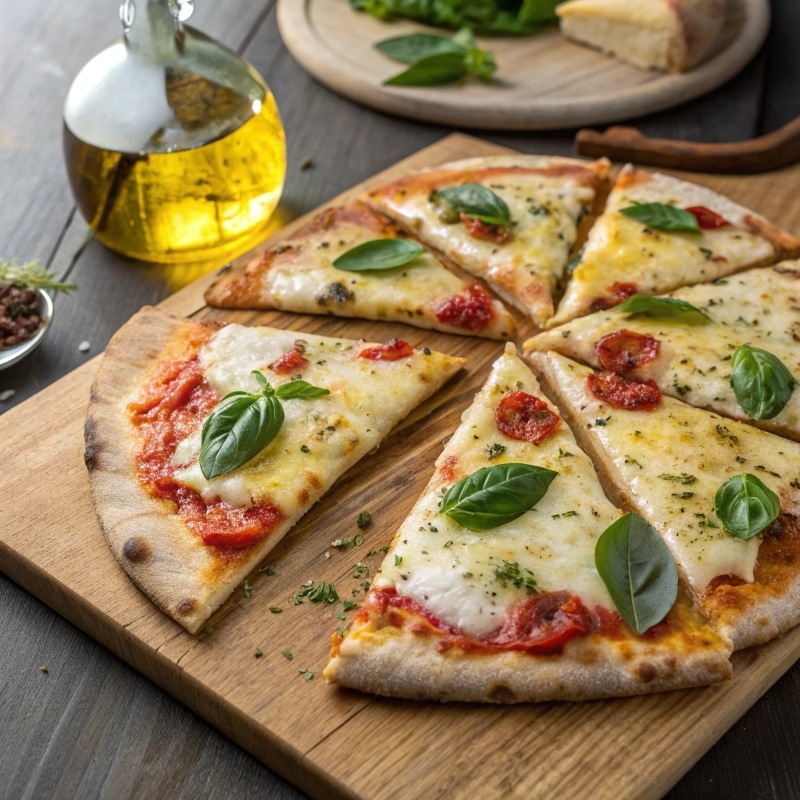Few dishes in the world spark as much passion as original Italian pizza. Born in Naples, perfected by Italian artisans, and adored around the globe, this iconic dish is more than just food it’s a piece of culture, history, and craftsmanship on a plate.
From the chewy, charred crust to the fresh tomato sauce and creamy mozzarella, authentic Italian pizza embodies the beauty of simplicity. Each ingredient plays a role, and every bite tells the story of Italian tradition.
In this recipe, we’ll show you how to make a classic Italian pizza that captures that same wood-fired flavor right at home.
Table of Contents
Print Recipe
Original Italian Pizza (Neapolitan Style)
Equipment
- Pizza Stone or Baking Steel
- Mixing bowl
- Wooden Pizza Peel or Baking Sheet
- Rolling Pin (optional)
- Oven (475°F / 250°C minimum)
Ingredients
For the Pizza Dough
- 2.25 cups all-purpose flour or Italian 00 flour for softer crust
- 0.75 cup warm water
- 1 tsp salt
- 1 tsp sugar
- 1 tsp active dry yeast
- 1 tbsp olive oil
For the Tomato Sauce
- 1 cup crushed San Marzano tomatoes
- 1 clove garlic minced
- 1 tbsp olive oil
- salt to taste
- fresh basil leaves
For the Toppings (Classic Margherita Style)
- 7 oz fresh mozzarella sliced
- fresh basil leaves
- olive oil for drizzling
Instructions
- In a small bowl, mix warm water, sugar, and yeast. Let it sit for 5–10 minutes until foamy.
- In a large mixing bowl, combine flour and salt. Pour in the yeast mixture and olive oil. Mix and knead for 8–10 minutes until smooth and elastic. Shape into a ball, coat lightly with olive oil, and let rise for 1–2 hours until doubled in size.
- For the sauce: heat olive oil in a skillet over low heat. Add garlic and sauté until fragrant. Stir in crushed tomatoes and a pinch of salt. Simmer for 10 minutes, add fresh basil, and set aside.
- Punch down the risen dough and divide into two portions. Stretch each ball gently by hand into a 10–12 inch circle, leaving edges thicker for a Neapolitan rim.
- Place the dough on a floured pizza peel or parchment paper. Spread a thin layer of sauce, top with mozzarella slices, basil leaves, and a drizzle of olive oil.
- Preheat oven with pizza stone to 475°F (250°C) for 30 minutes. Bake pizza for 7–10 minutes until the crust is golden and bubbly. If using a baking tray, bake for 12–15 minutes.
- Let the pizza cool for a minute, slice, and enjoy immediately for the best texture and flavor.
Notes
What Makes an Italian Pizza Authentic?
Authentic Italian pizza, especially the Neapolitan variety, stands out for its minimalist approach and quality ingredients. Forget heavy toppings and thick crusts Italian pizza is about balance, freshness, and texture.
Key Features of Traditional Italian Pizza:
- Thin, soft crust with slight charring from high-heat baking
- San Marzano tomatoes for authentic, sweet-savory sauce
- Fresh mozzarella (buffalo or fior di latte)
- Olive oil drizzle for richness and aroma
- Few toppings Italians let the dough and sauce shine
In Italy, pizza is treated with respect. It’s not overloaded with cheese or drowned in sauce; it’s crafted to highlight the natural flavors of the ingredients.
Equipment You’ll Need
- Pizza stone or baking steel (for that crispy, wood-fired texture)
- Mixing bowl
- Wooden pizza peel or flat baking sheet
- Rolling pin (optional many Italians stretch dough by hand)
- Oven that reaches at least 475°F (250°C)
Ingredients for original Italian pizza
For the Pizza Dough:
- 2¼ cups (280 g) all-purpose flour (or Italian 00 flour for a softer crust)
- ¾ cup (180 ml) warm water
- 1 tsp salt
- 1 tsp sugar
- 1 tsp active dry yeast
- 1 tbsp olive oil
For the Tomato Sauce:
- 1 cup crushed San Marzano tomatoes
- 1 clove garlic, minced
- 1 tbsp olive oil
- Salt, to taste
- Fresh basil leaves

For the Toppings (Classic Margherita Style):
- 7 oz (200 g) fresh mozzarella, sliced
- Fresh basil leaves
- Olive oil for drizzling
how to make Neapolitan pizza Step-by-Step
Step 1: Make the Dough
In a small bowl, mix warm water, sugar, and yeast. Let it sit for about 5–10 minutes until it foams.
In a large mixing bowl, combine flour and salt. Pour in the yeast mixture and olive oil. Mix until the dough starts to form. Knead by hand for 8–10 minutes (or with a mixer for 5 minutes) until smooth and elastic.
Shape the dough into a ball, coat lightly with olive oil, and place in a bowl. Cover with a damp towel and let rise for 1–2 hours in a warm spot until doubled in size.
Step 2: Prepare the Sauce
In a skillet, heat olive oil over low heat. Add garlic and sauté just until fragrant — don’t brown it. Stir in crushed San Marzano tomatoes and a pinch of salt. Simmer gently for 10 minutes, stirring occasionally. Add fresh basil and set aside to cool.
Step 3: Shape the Pizza
Once the dough has risen, gently punch it down and divide into two equal portions.
On a lightly floured surface, stretch one dough ball with your hands from the center outward until it’s about 10–12 inches wide. Avoid rolling too thin; the edges should be slightly thicker for that signature Neapolitan rim.

Step 4: Assemble the Pizza
Place the shaped dough on a floured pizza peel or parchment paper.
Spread a thin layer of tomato sauce over the base less is more. Arrange slices of mozzarella and a few basil leaves evenly on top. Drizzle lightly with olive oil.
Step 5: Bake
Preheat your oven (with pizza stone inside) to 475°F (250°C) for at least 30 minutes.
Slide the pizza onto the hot stone and bake for 7–10 minutes, or until the crust is golden, bubbly, and slightly charred.
If using a home oven without a stone, bake on a parchment-lined baking tray for 12–15 minutes.
Step 6: Serve It Like an Italian
Once baked, let the pizza cool for a minute, slice it into wedges, and enjoy it immediately. True Italian pizza is meant to be eaten fresh no waiting, no reheating, just that perfect moment of crisp-meets-chewy bliss.
Nutrition Benefits (Per Slice, Approx. 8 slices)
| Nutrient | Amount | Why It’s Good |
|---|---|---|
| Calories | ~210 kcal | Light and satisfying |
| Protein | 8 g | From mozzarella and flour |
| Carbohydrates | 26 g | Natural energy source |
| Fat | 8 g | Healthy fats from olive oil and cheese |
| Calcium | High | From fresh mozzarella |
Regional Pizza Varieties in Italy
Italy offers many pizza styles beyond Naples each with its own charm.
- Neapolitan Pizza (Napoli) Soft, chewy crust with minimal toppings.
- Roman Pizza (Roma) Thinner, crispier crust baked in rectangular pans.
- Sicilian Pizza (Sicilia) Thick, fluffy dough topped with tomato, onions, and anchovies.
- Pizza Bianca (Rome) A “white pizza” brushed with olive oil and herbs, no sauce.
Each region adds its twist, but the spirit of Italian pizza remains the same: simplicity, balance, and fresh ingredients.
Pro Tips for Perfect Italian Pizza
1. Use 00 Flour for the Best Crust
Italian 00 flour creates a soft, elastic dough that bakes into that perfect chewy texture.
2. Don’t Overload the Toppings
Keep it simple, quality trumps quantity. Too many toppings make the pizza soggy.
3. Crank Up the Heat
The secret to restaurant-quality pizza is high heat. A pizza stone helps mimic wood-fired conditions.
4. Use Fresh, Not Shredded Mozzarella
Fresh mozzarella melts evenly and adds creaminess without greasiness.
5. Add Olive Oil After Baking
A light drizzle of extra-virgin olive oil right before serving adds richness and shine.
Serving & Pairing Ideas
- Pair with a light Italian salad (like arugula and shaved parmesan).
- Enjoy with a glass of sparkling water with lemon.
- Serve alongside bruschetta or grilled vegetables for a full Mediterranean spread.
- End the meal with Tiramisu or Panna Cotta for an authentic Italian experience.

FAQS: pizza from Italy
Can I make Italian pizza without a pizza stone?
Yes! Use a heavy baking tray turned upside down to mimic the effect.
What’s the best flour for Italian pizza?
Use Italian “00” flour for an authentic, tender crust.
Can I freeze pizza dough?
Absolutely. Wrap it tightly and freeze for up to 3 months. Thaw overnight before baking.
What makes Italian pizza different from American pizza?
Italian pizza is lighter, uses less cheese, and focuses on quality ingredients rather than heavy toppings.
Can I make this vegetarian?
Yes, skip meat toppings and stick to the classic Margherita base of tomato, mozzarella, and basil.
Conclusion
The beauty of original Italian pizza lies in its simplicity fresh dough, a light hand with toppings, and a balance of textures and flavors. Whether you’re baking it in a home oven or dreaming of a Neapolitan pizzeria, this recipe brings a slice of Italy straight to your kitchen.
Authentic pizza is not about perfection; it’s about passion. So grab your dough, heat your oven, and enjoy the aroma of Italy filling your home.
For more authentic European recipes, check out our Chocolate Orange Cake
Follow Kenz Recipes on Facebook for more delicious ideas, behind-the-scenes baking, and quick meal tips.


